Most Asked Node.js Interview Questions with Answers
By Javascript Diary
April 1, 2023
Question - 1 : What is Node.js?
Answer:
Features:
- Asynchronous, Event driven, Non-blocking
- Single threaded but highly scalable
- Built on google chrome’s V8 Javascript Engine
- No buffering. These applications simply output the data in chunks
Where to use Node.js
- Data streaming application
- Data intensive real-time application
- JSON APIs Based application
- Single page application
Where not to use Node.js
- It is not advisable to use Node.js for CPU intensive applications because Node.js is single threaded and everything depends on the Event loop if there is heavy process then event-loop will be blocked totally
- Not suitable for big computation projects
Question: 2 - Explain Single threaded vs Multi threaded?
Answer:
Single threaded process contains the execution of instructions in a single sequence. In other words, one command is processed at a time. While a Multi threaded process allows execution of multiple parts of a program at the same time.
Question: 3 - How does Node.js run?
Answer:
Question: 4 - What is thread?
Answer:
Question: 5 - How Node.js handle multi threaded task?
Answer:

Question: 6 - Why is Node.js better than PHP?
Answer:
- Let’s take an example: suppose you have a tomcat server (PHP server) and we know PHP is a multi threading language. Now the maximum thread that can be created is 200. Now if more than 200 requests are coming at the same time, other clients will have to wait. Otherwise, You will need to increase the power of the server which is costly. But if you use Nodejs, it has an asynchronous feature that allows server to not wait for the response and handle new requests. Once the first service is ready, serve to the first client.
- Faster than PHP and python because of event-driven nature, Node.js can handle concurrent requests more than other web technologies.
- Can Node replace PHP? Yes, you can replace using server side Javascript.
Question: 7 - What are global objects?
Answer:
- __filename → give file name of the code be executed
- __dirname → name of the directory that the currently executing script resides
- setTimeout, clearTimeout(), setInterval(), processes exports, module, require ()
Question: 8 - What are pre-built module?
Answer:
Question: 9 - What is libuv in Node.js?
Answer:
Question: 10 - what are disadvantage of Node.js?
Answer:
- Not good choice of CPU intensive application
- It callback hell (hierarchy) make program more complicated and difficult to manage
- Less secure than python
- Need lots of code changes due to unstable APIs
Question: 11 - What is meant by Non-blocking?
Answer:
A longer/heavy process does not keep resources busy while executing. In this case asynchronous programing helps to achieve Nonblocking facility.
Question: 12 - What is the Event-loop in Node.js.
Answer:
- As we know that Node.js is a single threaded, event driven, Non-blocking runtime environment, this non-blocking I/O operation event-loop allows to perform .
- It is responsible to execute task from event queue if the call stack is empty.
- It also maintains the priority of the programs based on its phases.
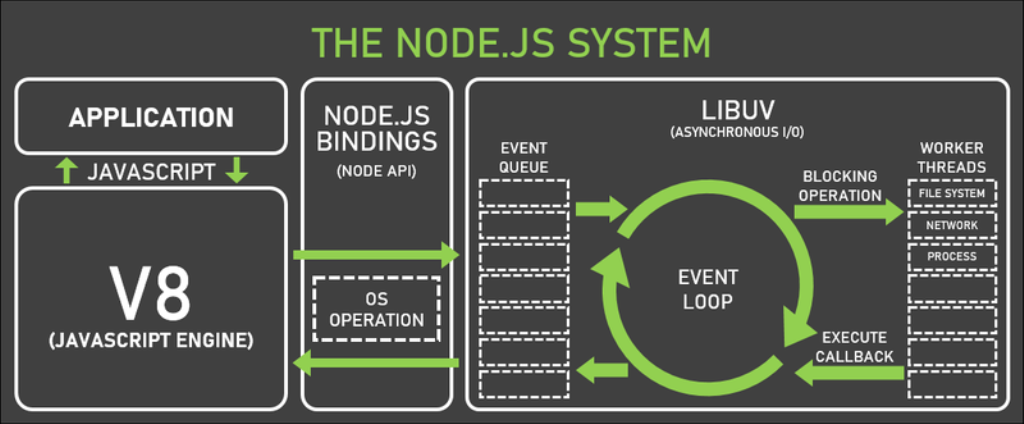
Question: 13 - What are the event loop phases?
Answer:
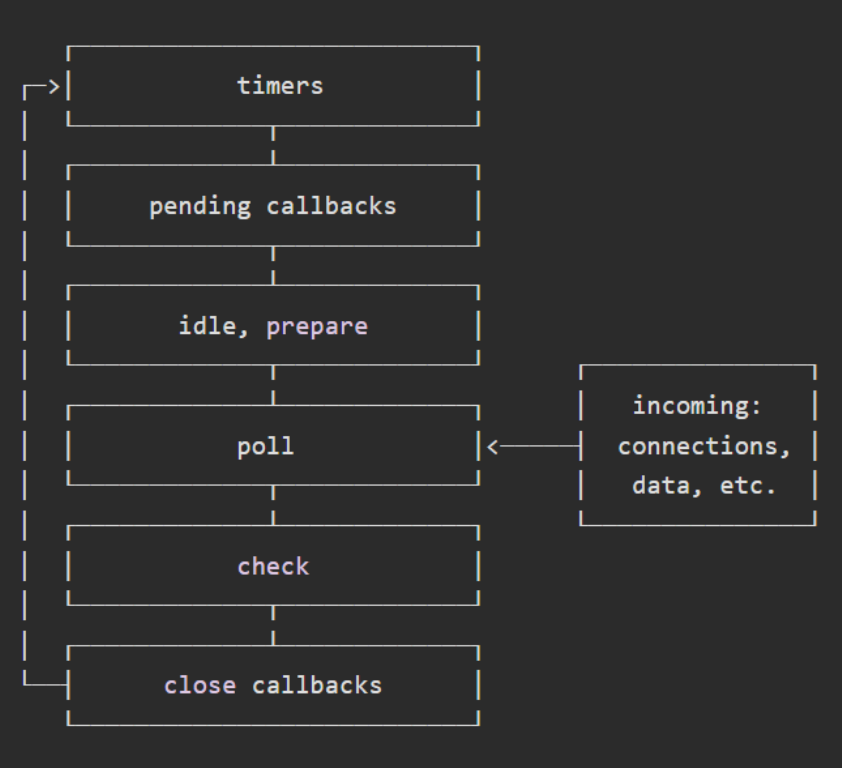
Poll: retrieve new I/O events; execute I/O related callbacks
Check: setImmediate() callbacks are invoked here.
close callbacks: some close callbacks, e.g. socket.on(‘close’, …).
timers: this phase executes callbacks scheduled by setTimeout() and setInterval().
pending callbacks: executes I/O callbacks deferred to the next loop iteration.
idle, prepare: only used internally.
Question: 14 - Priority of Excuting timers, promises, pending callback, process.nextTick()
Answer:
promises > process.nextTick() > setImmediate > setTimout, setInterval
Note: if you loop setImmediate inside another timer then setImmediate( ) will execute first otherwise in general, setTimeout excutes before setImmediate( )
Microtask Queue. The Microtask queue blocks the rest of the event loop from running until all Microtasks have been completed. Promises go into the Microtasks queue. This is why applications “wait” for Promises to resolve before moving on to the next task.
Microtask: promises, process.nextTick() microtask queue
Macrotask: setTimeout( ), setInterval( ), setImmediate( )
Microtask > Macrotask
Question: 15 - What are timers in Node.js?
Answer:
(I) process.nextTick ( )
- Executes just after one phase of event loop gets over and second yet to start
- It executes just after promises and before setTimeout ( ) and setImmediate ( )
- process.nextTick ( ) comes under microtask in event loop
- setImmediate( ) is processed in the check handles phase while process.nextTick( ) is processed at the starting of the event loop.
- process.nextTick( ) has higher priority than setImmediate()
(II) setImmediate ( )
(III) setTimeout ( ), setInterval( ) and clearInterval( )
setTimeout ( ) → Execute after a given time (in ms). it executes under the timer phase of the event loop.
setInterval ( ) → Execute once while render the code and loop executing within an time interval.
clearInterval( ) → Clears a timer set with the setInterval ( ) method.
Question: 16 - How to upload file in Node.js
Answer:
There are several packages for file uploading: multer, fileupload, formidable, busboy, express fileupload. Multer is a quite popular package. for multer to work, make sure that, in the HTML form tag , the enctype attribute must be set to multipart/form-data

Question 17:- How to use multer package?
Answer:

- dest – this shows where to store files , ( for avg used )
- storage – this also say where to store files ( but give more control )
diskStorage( ) which give you full control on storing file to disk In disk storage, there are two options:
destination → It is a function that is used to determine folder in which the file will be uploaded ( stored ) If no destination has given then, the operating system’s default directory for temporary file is used.
filename → It is a function that is used to determine what the file should be named inside the folder. If no filename is given, each file will be given a random name that does not include file extension. ( Note: you have to add file extension)
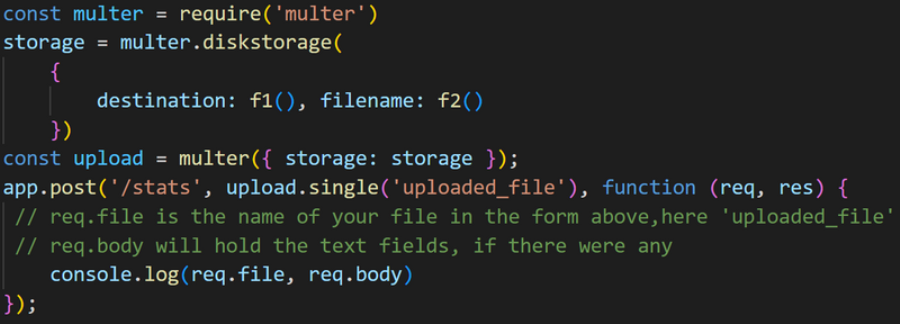
Question: 18 - How to use Passport module in Node.js for authentication?
Answer:
Passport provides several storage to use login. It can be username and password , facebook, Twitter and more. They have 500 + strategy
Major used are :-
- username & password
- Sign In with google
- Email magic link
- AuthO integration
Let’s talks about mechanism of passport:
- Strategies are responsible for authenticating requests, which they complete by implementing an authentication mechanism.
- Authentication mechanism defines how to encode a credential such as password in a request. It also specifies the procedure necessary to verify that credential. If credential is successfully verified, the request is authenticated
- There are variety of strategy published on npm registry
- The following command installs passport–local, a package which provides a strategy for authenticating with a username and password.
- Once a package has been installed , the strategy needs to be configured.
- For example, Localstrategy ( ) constructor takes a function as an argument. This function is known as the verify function.
- When authenticating a request, a strategy parses the credential contained in the request. A verify function is then called, which is responsible for determining the user to which that credential belongs.
- If the function ( verify function ) finds a user to which the credential belongs, and that credential is valid , it calls a callback with the authenticating user.
- If the credential does not belong to a known user, or not valid, the verify function calls the callback with false to indicate an authentication failure
- If an error occurs, such as the database not being available, the callback is called with an error.
Registering strategy:
passport.use ( strategy )
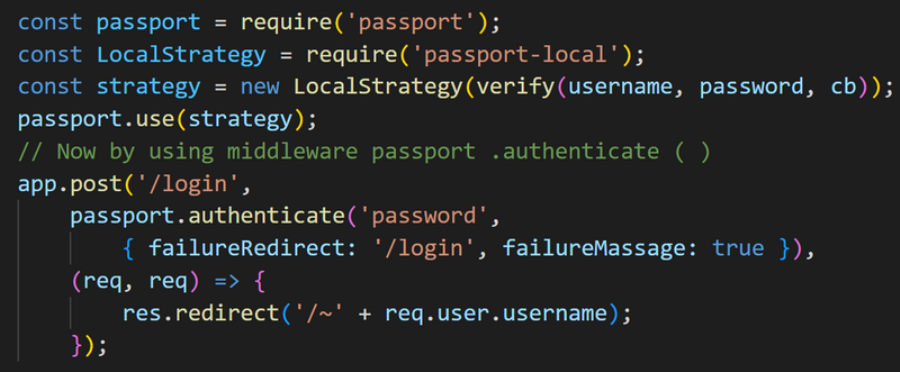
Question: 19 - What are difference between OAuth and OAuth2 ?
Answer:
- OAuth is a Technical standard for authorizing users. It is a protocol for passing authorization from one service to another without sharing the actual credentials, such as username + password.
- OAuth is one of the most common methods used to pass authorization from a single sign-on (SSO) service to another cloud Application.
- In OAuth , one application, sends another application an authorization token to give a user access instead of sending the user’s credential
- This token contains information about what privileges a user should have within the application.
- The token will also have a time limit.
- OAuth tokens are typically sent using HTTPS, meaning they are encrypted. They are sent at the layer7 of the OSI model.
- OAuth 2.0 is the latest version of OAuth. There were some vulnerability in OAuth which were fixed in OAuth 2.0
Question: 20 - What are the difference between JWT vs OAuth?
Answer:
- JWT is a token format
- OAuth is a standardized authorization protocol that can use JWT as a token.
- JWT can not logout because there is no track of the token on the server side. So, if you want to do real logout then go with OAuth.
- JWT is serial and not encrypted so it can be seen by anyone.
- JWT is good for API authentication and server to server authorization. It is not good choice for sessions.
Question: 21 - What is difference between Authorization vs Authentication?
Answer:
Authentication is the process of verifying the identity of a user by obtaining some sort of credentials. For example: username and password combination and using those credentials to verify user identity.
Authorization is the process allowing an authenticated user to have the access rights to the system. You can control access rights by granting or denying specific permissions to an authenticated user.
Note: First authentication and then authorization takes place.
Question: 22 - What is middleware and it's usage?
Answer:
- Middleware is a function between request and response of your route.
- This can be applied to all routers or or a specific router.
- It has access to the request object, the response object and the next() function.
- The next() function is a function in the express router and when invokes , executes the middleware succeeding the current middleware
- If the current middleware function does not end the request-response cycle, it must call next() to pass control to the next middleware function. Otherwise, the request will be left hanging.
Middleware function can perform:-
- Execute any code
- Make changes to the request and response object
- End the request-response cycle. Call the next middleware in the stack.
- A middleware can be before response and after response as well.
- To use middleware for a specific route, place it in the route
- app. get (“/”, middleware, (req,res)=>{ });
- To use global, app.use(middleware);
Question: 23 - What is a microservice in Node.js?
Answer:
A Microservice is an application architecture that takes every application function and puts it in its own service, Isolated from others. These services are loosely coupled and independently deployable. This architecture emerged as a solution to the old monolithic approach to web application development. In monolithic software, everything is built as one unit. All business logics are grouped into one extensive application. This approach complicates the process of updating a codebase because it affects the entire system. Even the small code changes require building and deploying a new version of the whole software. Additionally, Scaling an application-specific function means you have to scale the entire application. Microservices resolve these challenges of monolithic system by fragmenting the application from a whole into several smaller parts.
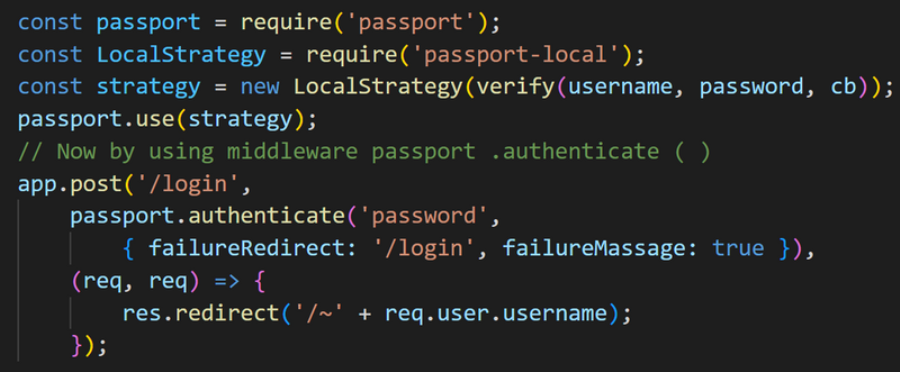
Benefits of monolithic Services:
- Language Agnostic: – Microservices are not limited to a specific programming language.
- Scalability: if a larger developer team is working, then responsibility can be shared between the developers
- Unlimited Iteration
- Unit Testing: It is easier for a developer to write a test script to validate the specific functionality.
- Suitable for SAAS based application development.
Monolithic applications can be difficult to scale horizontally as the entire application must be replicated. This becomes harder if the application depends on a single database. Microservices, on other hand, can be scale, duplicated, or load-balanced depending on the individual services.
Question: 24 - Does Node.js supports typescript?
Answer:
Yes. Node.js supports typescript.
- First thing to do is – install typescript in your project using command: $ npm i -D typescript ( this install typescript compiler )
- Now we can compile it to Javascript using tsc command $ npx tsc example.ts
- This command will result a new file named example.js that we can run using Node.js
Question: 25 - What is REPL?
Answer:
Question: 26 - Why is Node.js single threaded?
Answer:
Node.js is not single threaded. The Node.js event loop operates on a single thread, yes, but the asynchronous blocking operations are delegated to separate worker threads. These threads notify the main thread when they are done processing. Event loop also known as main thread.
worker_threads module can be used to create more {worker} and make it a multithreaded
worker_threads module enables the use of threads that execute Javascript in parallel.

Question: 27 - What is stream in Node.js?
Answer:

Question: 28 - Why should we use Stream?
Answer:
- Memory Efficiency → You don’t need to load a large amount of data in memory before you are able to process it.
- Time Efficiency → It takes significantly less time to start processing data as soon as you have it, rather than having to wait with processing until the entire payload has been transmitted.
Question: 29 - What are 4 Types of streams in Node.js:
Answer:
- Writable → Streams to which we can write data. For example, fs.createWriteStream( ) allow us to write data to a file using streams.
- Readable → Streams from which data can be read.
- Duplex → Streams that are both Readable and writable for example: net.Socket
- Transform → streams that can be modified or transform the data as it is written and read. For example: in file compression, you can write compressed data and read decompressed data to and from a file.
Question: 30 - What is pipeline ( )?
Answer:
Pipeline ( ) → Pipeline is a mechanism where we provide the output of one stream as the input of another stream. There is no limit on piping operation.
Stream.pipeline ( ) → This is a module method to pipe between streams forwarding errors and properly cleaning up and provides a callback when pipeline is complete. An example can be: reading a video file, compressing it and then writing it back to drive.

Question: 31 - What is Node.js buffer?
Answer:
Question: 32 - Why should we use buffers?
Answer:
Question: 33 - Why should there be separate express app and server file?
Answer:
Benefits
- Faster testing execution
- Allows and deploying the same API under flexible and different network conditions.
- Cleaner Code
* * * API declaration should reside in app.js
* * * Server network declaration should reside in /bin/www:
Question: 34 - Why V8 engine?
Answer:
Question: 35 - What is exit () in node.js?
Answer:
- In Javascript there are 3 major exit function:- Return, break, or throw
- exit ( ) function in Node.js
- Exit code 1 is used when unhandled fatal exceptions occur that were not handled.
- Exit code 0(zero) is used to terminate when no more async operation are happening
- exit ( ) . When Node.js runs this line, the process is immediately forced to terminate any running process like:- Callback , filesystem, network request etc.
Question :- 36 What is stub in Node.js?
Answer:
- we use for testing . stubs are functions or programs that affect the behavior of components and modules.
- There are dummy objects for testing.
- It implements a pre-programmed response.
- Makes easy testing for synchronous code
Question: 37 - Can you explain Event (custom Event & Event Emitter)
Answer:

Question: 38 - How do you measure the duration of async operation in Node.js?
Answer:

Question: 39 - What is WASI ( WebAssembly System Interface)?
Answer:
Question: 40 - What is clustering in Node.js?
Answer:
- As we know that Node.js is a single-threaded application that means when it runs, it is only utilizing a single core. Hence, if the server is multicore and even it is capable of handling heavy load, it would not be able to handle it. This is where the cluster comes from.
- With the help of a cluster, we can create several instances that will distribute workloads among their application threads.
- When process isolation is not needed, use the worker_threads module which allows running multiple application threads within a single instance.
- Having a multi thread to handle requests, improves the throughput ( request/second ) of your server as several clients can be serve conncorrently
- Cluster module uses a round robin to handle the request
- The Node.js cluster enables the creation of child processes (workers) that run simultaneously and share the same port. Each newly created child has its own event loop, memory and V8 engine.
- If there is a long running / blocking operation on one worker, the other workers can continue handling other incoming requests. Hance your app won’t have come to a standstill until the blocking operation completes.
- Running multiple workers also makes it possible to update your app in production with little to no downtime.
Question: 41 - What is the Child process?
Answer:
It is being created by the main process. One particular reason for creating a child process is avoiding the main server from being blocked by anything.
There are 4 methods to create child process–
Spawn ( ), Fork ( ), exec ( ), exefile ( )
fork ( ) method is popular among them to create a child process.
Question: 42 - What is thread pool and which library handles thread pool in Node.js?
Answer:
In general, threadpool is a software design pattern achieving the currency of execution in a computer program. In Node.js, there are two types of threads: one Event loop (aka main loop, main thread) and a pool of k workers in a worker pool ( aka threadpool ). In Node.js, worker pool is for
expensive tasks.
- The workerpool of Nodejs is implemented in libuv (doc)
- Node.js modules like DNS dns.lookup ( ), dns.lookupService(), file system, crypto and zlib APIs use Libuv’s thread pool.
Question: 43 - How does Node.js decide what code to run next?
Answer:
Question: 44 - Why do we use routing?
Answer:
Question: 45 - What are the differences between NPX and NPM?
Answer:
- NPM is a tool that is used to install the package whereas.
- NPX is a tool that is used to execute packages.
- Packages used by NPM are installed globally.
- Packages used by NPX not installed globally.
Question: 46 - What are differences between NPM and YARN?
Answer:
Both are package manager:
- NPM comes along with Node.js installation. YARN, you have to install.
- YARN has equivalent file called yarn.lock where NPM has package.json
- YARN stores everything locally that’s why we use yarn add command
- NPM – everything stored on an online repository that’s why use npm install.
Which one is best? YARN has better speed and performance. While NPM installs dependency packages sequentially, YARN install in-parallel. Because of this, YARN performs faster than NPM when installing large files.
Current Version of Node.js
Current version is 18 and 16.XX is LTS (long term support)
Question: 47 - Managing outdated package, vulnerability and security in Nodejs?
Answer:
The more packages we use, the higher the risk of having vulnerable or malicious packages amongst them.
This hold trve not only for the packages you use directly but also for the indirect dependency they use
Below command can show dependencies
$ npm ls — prod – -long
prod – package in production environment
long – display description of package
There are few set of question that can be considered while talking about
security & vulnerability:
Question 1 Which package I am using?
Question 2→ Does this package have known. Security vulnerabilities.
Question 3→ I am still using this package;
Question 4→ Are other developers using this package?
Question 5→ Am I using latest version of package.
Question 6→ when was this package last update.
Question 7→ How many maintainers do these package have?
According to the synk’s data, about 76% of Node shops use vulnerable
dependencies in their application
Solution:
You can usually find such vulnerable package using synk. You run synk test
in your terminal Synk is developer security platform direct integrating into
development tools.
> NPM install synk
> synk test
Question: 48 - How will you be Debugging Node.js ?
Answer:
Node.js which runs on the google V8 engine does support setting break point using remote debugger protocol
That’s what – inspect argument is for.
Step to debug
There is a file called launch. Json in visual studio code folder which has the instruction of launching debugger
Click the debug button and the click of create a launch.json file
This file gives what kind of debugyer you want: set up a breakpoint and then
hit the run button in the debug wizard.
– – inspect
If we launch the application with debugger, we can debug it but what if we
want to attach the debugger
After launching or what if you want to run the application and the attach
the debugger later
that’s what inspect does.
How to use it
Node – – inspect index.js > file name of what you want to debug
Now this will run the application and turns on the debugger.
To attach debugger we have to modify launch.json with option to attached process.
inspect – brk → debugger starts but application stops immediately at the first line of javascript.
You can use this wode if you want to debug the loading of the script.
Question: 49 - How to deploy a Node.js stack Web app?
Answer:
Dynamo DB → is fast and flexible No SQL database.
Amazon simple Notification service (SNS) to configure push notification for your app.
What is beanstalk→ it is a service for deploying and scaling web application
What is EC2 → AWS service that allow you to create a server in AWS cloud. Elastic beanstalk is one layer of abstraction away from the EC2 Layer.
What is lambda → AWS lambda lets you run code without provisioning or
managing server. It is event driven, serverless computing platform provided
by amazon.
Difference between lambda & Beanstalk?
Both are great choice, but serves different purpose. Lambda is simpler and
less expensive, while Elastic Beanstalk let’s you run full application and
gives you control over the environment.
Question :- 50 Steps to host MERN stack application on AWS
Answer:
Step 1→ create an new ubuntu server instance on EC2
Step 2→ connect to ubuntu server via SSH
Step 3→ setup web server with Node.js + mongo DB + NGINX
Step 4→ Deploy Backend API
Step 5→ Deploy front end API
Step 6→ configure NGINX to serve the Node.js API and REACT front end.
Step 7→ Test your mern stack application.
